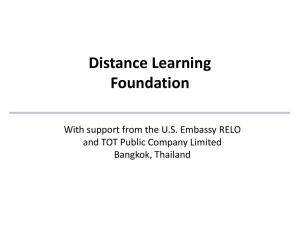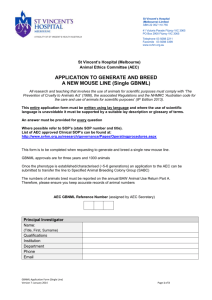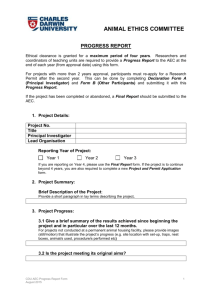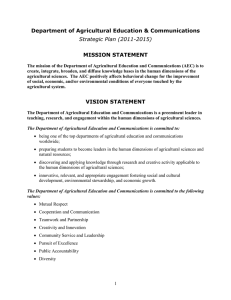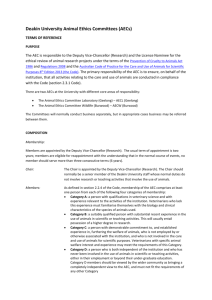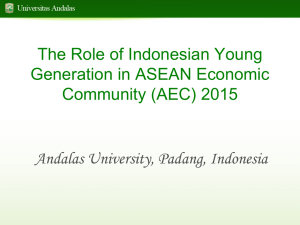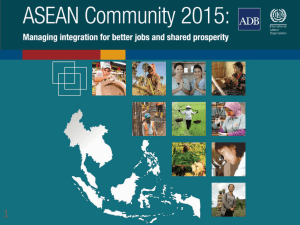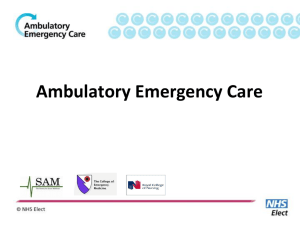File
advertisement
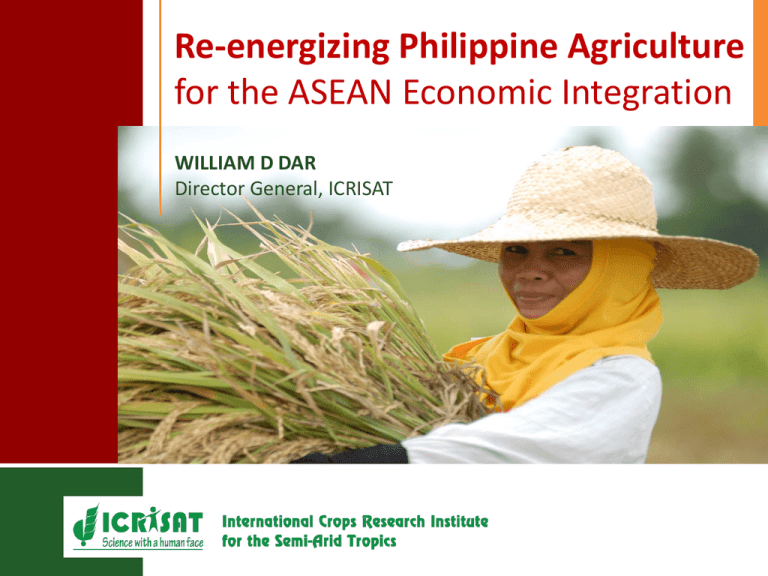
Re-energizing Philippine Agriculture for the ASEAN Economic Integration WILLIAM D DAR Director General, ICRISAT ASEAN Economic Community (AEC) 2015 Free trade + effective policies = promise of inclusive growth and development Is Philippine agriculture ready for AEC? The Philippine agriculture scenario GDP contribution of agriculture ⁻ ⁻ Net food exporter to importer since late 1980s Important to food security and economy ⁻ ⁻ Main source of domestic foods Employs 11.8 million or 35.1% of total workforce Poverty in rural areas ⁻ ⁻ 11% of GDP in 2012 From 20 to 30% in last two decades Half of 100 M live in rural areas 80% of country’s poor Dominated by smallholder agriculture ⁻ ⁻ Lack of access to markets, credits, technology Poor infrastructure Performance of Philippine agriculture Daunting task – producing more food from less land and water Imports as alternative food sources ⁻ ⁻ World price spikes jeopardize food security Threatens livelihoods of smallholder farmers Rice production serves to meet food security goal ⁻ ⁻ Rice, one-third of harvested area (2011) Followed by coconut and corn; far behind, banana and sugarcane Crops account for 60% of agricultural GVA Shift to “high value” crops crucial Trade in agricultural commodities Exports growing, imports growing faster Imports, mostly driven by rice, soared in 2008 95% self-sufficient in rice (2011) Top export earner, coconut oil (26%) 100% selfsufficient in corn AEC regional integration pillars Challenges under AEC (1) Single market and production base pillar ⁻ ⁻ ⁻ Food, agriculture and forestry are priority sectors Removal of tariffs to boost agricultural trade Harmonization of quality management systems for food safety Review of Philippines’ progress in meeting commitments under AEC ⁻ ⁻ 45.7% in AEC scorecard; average ASEAN score is 67.5 % World Bank’s Ease of Doing Business Report: Philippines’ rank dropped from 141 in 2009 to 144 in 2010 Challenges under AEC (2) Factors limiting gains from globalization ⁻ ⁻ ⁻ ⁻ Current strategy highly conservative ⁻ ⁻ ⁻ ⁻ Low investments in infrastructure; Lack of political will to implement a sustained and credible fiscal reform program; High transaction costs; and Lack of a coherent industrial policy. Prioritizes traditional crops Production targets only close domestic supply-demand gap Policy protects domestic markets with tariffs and nontariff barriers. “Import substitution agricultural development” Good governance, committed leaderships with political will for genuine reform vital Major opportunities for Phil agriculture (1) Creating a diversified, dynamic and competitive agriculture sector Overcoming non-tariff barriers by modernizing agricultural enterprises ⁻ More capital, better input use and technology packages Enhanced regional cooperation in dismantling non-tariff barriers ⁻ GAP, GAHP, GHP, GMP and HACCP Major opportunities for Phil agriculture (2) Technology transfer and farmers’ access to knowledge and scientific research ⁻ ⁻ Collaborative R&D among member-countries Global networks in agricultural S&T Promoting efficiency and competitiveness in agriculture ⁻ ⁻ ⁻ ⁻ Freer flow of capital and investments Expanding production to take advantage of potential economies of scale Greater market access and better processing facilities and roads Information and transport services A New Philippine Agriculture Roadmap under the AEC Platform “Towards an inclusive, science-based, resilient and market-oriented Philippine agriculture” Are we ready to take advantage of, or even just survive and compete under the AEC regime? Rice production in 2013 = 18.44 M tons, 8% less than FSSP target of 20 M tons. Resilience in production of food staples to the impacts of climate change has yet to be addressed. Agricultural and food policies must adopt a holistic approach. Enabling strategies for a holistic, agriculture-led economic growth 1. Technology development – Improves yield, quality and value of produce – Prevents losses and conserve the environment – Results in improved productivity, profitability, competitiveness and sustainability 2. Public and private investments – Physical infrastructure, rural credit, human capital and institutions essential for agricultural modernization 3. Inclusive Market-Oriented Development (IMOD) – Linking farmers and small and medium enterprises (SMEs) to markets – Enhanced public-private sector collaboration 4. Reforms in governance – Binding force for enabling strategies for a competitive agricultural sector Focus areas under an AEC regime (1) 1. Balance between rice self-sufficiency and crop diversification – Self-sufficiency in rice production along with diversifying into high-value crops with comparative advantage 2. Sustainable resource management – Land use plan, soil and commodity mapping, water management 3. Linking farmers to markets (IMOD) – Giving farmers access to innovations designed for the poor, to help them connect to markets – Building their own resilience rather than creates dependency IMOD: A new approach Inclusive Market-Oriented Development (IMOD) Climate change adaptation for smallholder, rainfed agriculture Focus areas under an AEC regime (2) 4. Developing climate-smart agriculture – Increasing stocks of livelihood capital and biophysical resilience of the system 5. GAP, sanitary and phytosanitary standards, and HACCP compliance – Harmonize standards; develop exporters’ capability to conform to SPS and NTBs 6. Innovative use of ICT in knowledge and information sharing – Leveraging the power of ICT to support smallholders in processing, marketing and realizing market opportunities Focus areas under an AEC regime (3) 7. Increase in public investment to attract private sector participation – More public investment to attract more flow of private capital to ensure sustainable economic growth by increased volumes of trade 8. Enhanced role of youth in agriculture – Promoting profitable and modern productivity augmenting livelihood projects – Education system to address agri-innovations, entrepreneurship and agri-business, etc. 9. Championing appropriate policies – Appropriate laws, policies, rules and regulations to make public institutions work and to encourage broader stakeholder participation Sustainable and inclusive growth of smallholder agriculture Investments in smallholder agriculture ⁻ ⁻ Can lift people from poverty and food insecurity Under AEC, must become active players in the supply chain Smallholder farming can transform rural landscape ⁻ ⁻ ⁻ A new and sustainable agricultural revolution Needs policy environment to support and nurture them Can become commercially-oriented and profitable farming Food security for all 24% of families (4.3 million households) are hungry due to rising food prices How do we feed the projected 150 million Filipinos by 2050? Under the AEC, food security through regional trade and cross country cooperation to raise productivity must be our top priority. A Five-Step Plan to Feed the World (National Geographic Magazine) Step 1: Freeze agriculture’s footprint Step 2: Grow more on farms we’ve got Step 3: Use resources more efficiently A Five-Step Plan to Feed the World (National Geographic Magazine) Step 4: Shift diets Step 5: Reduce waste Feeding the hungry is not a need, but a moral imperative. We have to make Philippine agriculture competitive. Thank you! ICRISAT is a member of the CGIAR Consortium
